Introduction
David Burrows
Dean Kenning
Peter Lewis
Simon O’Sullivan

|
|
What’s the Use of Art? - Dean Kenning
To ask ‘what’s the use of art?’ is to invite accusations of cynicism if the question is rhetorical, or philistinism if the question is sincere. I would like to insist on the contemporary relevance and necessity of questions about the social use of art in the context of the coalition government’s public spending cuts (estimated at £81bn), with particular reference to the 29% cut in arts funding, and the 100% cut in the block grant for University teaching in Arts, Humanities and Social Science, alongside a tripling of student fees. Specifically I want to draw attention to a collective spirit which developed out of the student protests and the fight against the privatization of education; a spirit witnessed, in an art context (although this is perhaps still a marginal phenomenon) in college occupations, teach-ins, radical organizational and discursive events, and politically active forms of art beyond officially sanctioned spaces of galleries and the like (in squatted ‘free schools’, on demonstrations, etc.).
To begin with some ancient history. ‘Use’ got a bad name from New Labour’s ‘instrumentalisation’ of art – thought of either in terms of economic value, and the rhetoric of the ‘Creative Industries’, city branding and regeneration; or else (although crucially the two are linked) in terms of its social value, and the policy rhetoric of ‘social inclusion’. While there was much to criticize, the argument of those in the art community opposed to this form of indirect instrumentalisation often fell back on the ‘get out of jail free’ catch-all notion of autonomy.II ‘Autonomy’ is a complex term, and one which I believe is necessary to maintain for an articulation of art’s critical agency, but in the prevailing cultural conditions it often gave philosophical cover 1. to a type of art which conformed easily to the burgeoning contemporary art market, and, 2. the pursuit of a wholly individualistically-conceived professional career. What we have witnessed over the last 25 years or so is a massive commodification of art, but also the commodification of the artist and his or her personal relations (the culture of prestige and value by association so intrinsic to the pursuit of art career success). So while ‘autonomy’ may be one way to describe art’s institutional separation from everyday life, as materialized through framing devices such as the gallery and a whole discourse of ‘critical distance’, the kind of artworks and artists which were valued and visible were found to be eminently useful: firstly, for the market and the enormous profits which could be made; secondly, for the individual artist as a pathway to personal status and success.
Today the commodified and individualistic culture of art remains; what is ancient history is the kind of instrumentality vs. autonomy debate that could only occur with a government eager to pursue its own social agenda through the state funding of art. Whilst certain institutional arrangements promoting inclusion remain for the time being, the clear new ideological agenda is to withdraw from state funding and let the market instrumentalise all on its own. The consequences of the arts and local government cuts, and the privatization of higher education, will be to make the pursuit, pleasure and practice of art a luxury for the rich, and also to establish more firmly than ever that, when it comes to art, it is the market that rules – in the form of sales, commissions and sponsorship. Whilst this is depressing, I would nevertheless like to focus on encouraging developments that Government backing for Lord Brown’s recommendations for education inspired; but before I consider the activities coming out of the student demonstrations I want, by way of contrast, to look at the art establishment’s reaction to the cuts in funding.
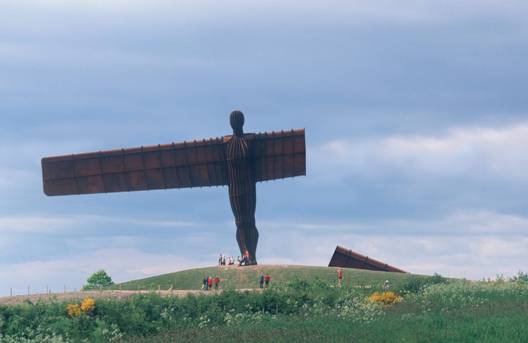
Cornelia Parker, ‘Why clip the wings of an industry that is soaring? It’s a false economy to cut the arts’
[Save the Arts website]
The Save the Arts campaign, targeted at Culture minister Jeremy Hunt’s proposed 25% cuts in art funding (he ended up enthusiastically cutting even more than that) was first of all limp and defensive, begging the government to ‘cut us don’t kill us’. It was also, despite its good intentions and reference to the value of ‘art for all’, distinctly top-down and conservative, adopting a two-pronged approach fitting perfectly with the commodified character of the art world I have been describing. Firstly, what was emphasized was art’s economic benefit to the country - art is a ‘Great British Industry’ that shouldn’t be destroyed; secondly, the campaign proceeded entirely according to a celebrity culture of prestige – one hundred or so art world signatures to encourage the rest of us to sign up invisibly, and week-by-week campaigning artworks by a hand-picked selection of famous artists.III So is the limit of art’s social ambition an economic one? And should we really want to ‘save’ art in the hierarchical, professionalized and socially divided form it currently takes? Shouldn’t we rather be asserting what art could be? Isn’t it this radically transformational aspect which has always given life to art? It may be that this informing spirit implies, at this moment in time, a decisive turn towards the social sphere.
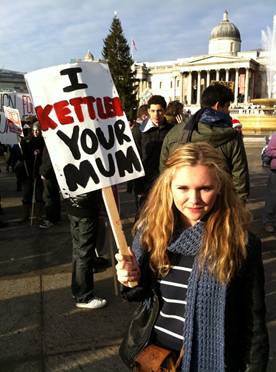 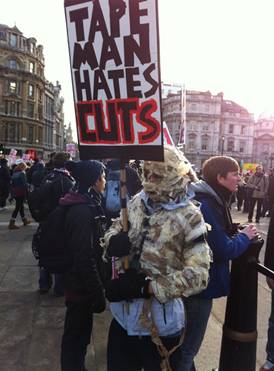
Final Education Demo, London, 9 December
(The date of the House of Commons vote on raising tuition fees)
[Photos: Dean Kenning]
Against the pervasive individualism of the art world a new collective spirit has fed into art from the militant energy of the student protests in the form of college occupations, educational and activist workshops, teach-ins and organizing groups.IV It is a spirit of exhilaration and empowerment, an effect of coming together with others, escaping the self and producing work not for personal economic benefit or cultural capital, but for a higher goal: the defeat of the government cuts agenda. It marks a shift away from the pervasive culture of the market and the individual, even if this at present remains tied to direct opposition to politicians, bankers and the like in a way which is not always easy to connect with the structures and relations of culture and the art world (which is too often still regarded as an unproblematically neutral or progressively liberal space). Art students, like others, have been politicized, have made connections beyond a narrow discourse and series of texts, opening out to questions of economy, law and resistance – finding solidarity at a local and - via the internet and social networking - global level. In other words, the production of art and the agency of the artist became, in this short, intense period of time, about direct engagement with life and the way it could be.
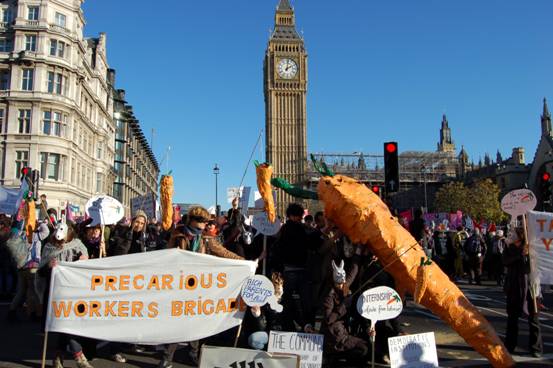
First Education Demo, London, 10 November.
(This is just prior to the storming of Millbank Tower).
[Photo: Precarious Workers Brigade/Carrot Workers Collective]
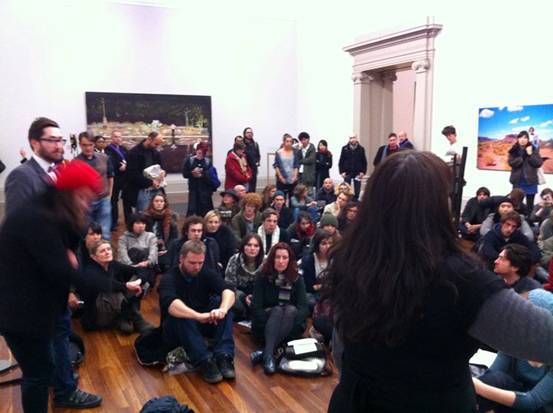
Tate Turner Prize Teach-In, 6 December
[Photo: Dean Kenning]
Is it possible for us to distinguish use from instrumentality? Can we talk about the functional value of art without it being something we can measure and calculate – without, in the process, integrating it to the point where it is swallowed up into other processes and agendas? Could we hope that art be useful without this implying that it become a mere means to another end? In a response to the University cuts and reactions to them Alain de Botton gave a short talk on Radio 4 where he accused arts and humanities academics of having themselves to blame for the withdrawal of teaching money because they hadn’t done enough to promote the functional value of their subjects. I wouldn’t agree with this exactly, but I don’t think the problem with de Botton’s polemic is his claim that art and philosophy should be useful. The problem is that he strips all political and critical substance from art and philosophy, so that they can play the role of consoling council for individuals encouraged to come to terms with reality, and self-help guides in how to adapt to a changing world. Philosophy, in other words, can be used to adjust humans to reality. De Botton may be dismissed as someone not to be taken too seriously as an academic and philosopher, but unfortunately it is precisely his simplifying and depoliticizing narrative of adaptive selfhood which recommends him to the UK broadcast media and therefore marks him, depressingly, as a current version of the public intellectual. This is precisely why counter arguments for the use-value of apparently functionless activities like philosophy and art need to be stated assertively, particularly as the unstated aim of the targeted education cuts is to make arts and humanities subjects an intellectual hobby for the well off (and following from this, to crush any potential it might have as a tool by which society can be challenged and altered by those in whose interests it is to do so). Of course the problem immediately arises that any discussion that offers more complex and political conceptions of the social function of art and humanities will be ignored by a media who’s simplistic discourses it challenges, but this only makes the matter of creating a counter public discourse, through whatever channels are open, more pressing. I would like to propose that art might have a democratic function in an antagonistic sense, questioning and contesting what is offered as the truth, in a manner specific to art. Henry Giroux, the radical educationalist, has spoken of the democratic necessity for forms of social discourse to counter what he calls the ‘public pedagogy’ of a mass media that ‘refers to a powerful ensemble of ideological and institutional forces whose aim is to produce competitive, self-interested individuals vying for their own material and ideological gain.’V Rather than exemplifying a form of this commodifying discourse, which it certainly does in its present state, art could draw on its provocative, critical, de-naturalising and disobedient avant-gardist traditions in a way that effects change now, rather than remaining safely institutionalized whilst waiting for social change to happen elsewhere. Not that art can change the world, but it can hopefully change aspects or parts of it.
Finally – and speaking as an artist – I think that art should not be afraid of becoming activism; not because activism is the goal of an art which desires a social function, but, on the contrary, because good art can risk stepping beyond the designated borders of institutionalized art without fear of becoming simply activism. I would maintain that art is different from activism; that it acts, is active according to different modes and criteria. Art will only be specifically useful if it maintains its strangeness, its darkness, its ability to disturb, to tap into the unconscious; if it maintains, that is, its character of producing something we don’t recognize – that moment of blockage and dumbfoundedness which acts as a sign to lead us beyond ourselves – which is, more or less, how Deleuze describes thinking.VI To think about art and use, in other words, has got nothing to do with exorcising cultural guilt, or selling art’s soul – the autonomy which allows it to escape cultural conformity – for a clean social conscience. It has everything to do with leaving market-friendly but socially irrelevant art behind and asserting the transformative spirit of an art worthy of its times.
I This paper (now slightly revised) was presented as the introduction to the Symposium ‘Art: What’s the Use?’ held at the Whitechapel Gallery on the 14th January 2011.
II See the collection Art For All? Their Policies and Our Culture, ed. Mark Wallinger and Mary Warnock, Peer: London 2001.
III The impression that what was being presented in visual art’s defense was a bunch of artworld luvvies is encouraged by the dull, corporate worthiness of the works produced, lending the sense of a mutual appreciation society. (Hilariously a comment posted in response to Cornelia Parker’s image of Anthony Gormley’s Angel of the North with a wing clipped stated simply: ‘At Last!’). One need only compare these sanctioned offerings with the very many humorous, inventive and angry DIY banners made by students and others on the education demos, to appreciate the difference between a stunted, homogenous individualism and an energetic singular collectivism.
IV For a report and analysis based on my own involvement with some of these activities see ‘Protest, Occupy, Transform’, Art Monthly, February 2011.
V Henri A. Giroux, Border Crossings, Routledge: London and New York, 2005, p.4.
VI Gilles Deleuze, Difference and Repetition, ‘Chapter 3: The Image of Thought’, trans. Paul Patton, Columbia: New York 1994
2011
|
|
|